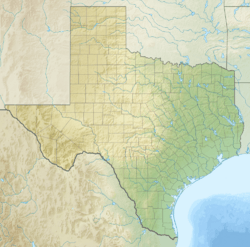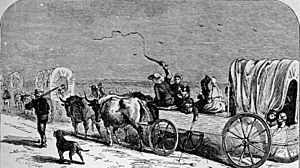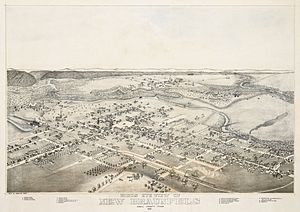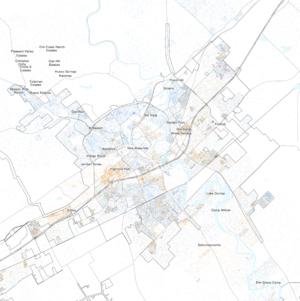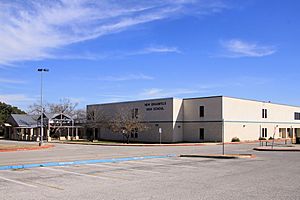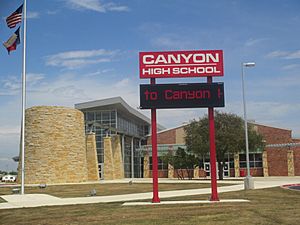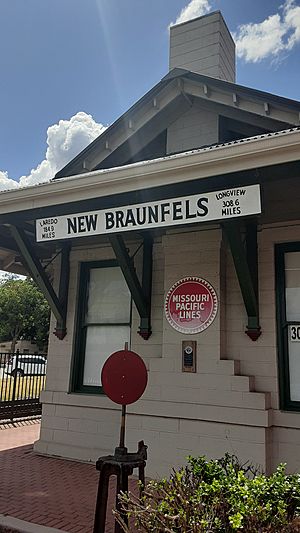New Braunfels, Texas facts for kids
Quick facts for kids
New Braunfels, Texas
|
|||
|---|---|---|---|
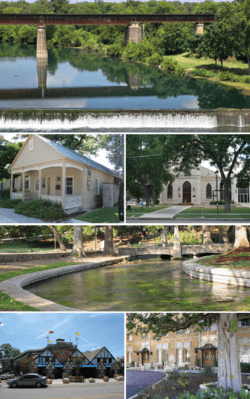
Top, left to right: Guadalupe River, August Dietz Cottage, First Protestant Church, Comal River in Landa Park, Schlitterbahn, Hotel Faust
|
|||
|
|||
| Motto(s):
In Neu Braunfels ist das leben schöne (In New Braunfels, life is beautiful)
|
|||
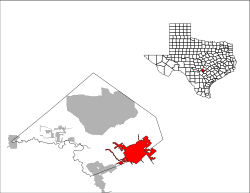
Location of New Braunfels in Texas
|
|||
| Country | |||
| State | |||
| Counties | Comal, Guadalupe | ||
| Founded | 1845 | ||
| Government | |||
| • Type | Council-Manager | ||
| Area | |||
| • Total | 45.57 sq mi (118.02 km2) | ||
| • Land | 45.18 sq mi (117.01 km2) | ||
| • Water | 0.39 sq mi (1.00 km2) | ||
| Elevation | 620 ft (190 m) | ||
| Population
(2020)
|
|||
| • Total | 110,958 | ||
| • Density | 2,434.89/sq mi (940.16/km2) | ||
| Time zone | UTC−6 (Central) | ||
| • Summer (DST) | UTC−5 (CDT) | ||
| ZIP Codes |
78130–78133
|
||
| Area code(s) | 830 | ||
| FIPS code | 48-50820 | ||
| GNIS feature ID | 2411228 | ||
New Braunfels (![]() i/ˈbrɔːnfəlz/ BRAWN-fəlz) is a city in Texas, USA. It is located in Comal and Guadalupe counties. New Braunfels is the main city, or seat, of Comal County.
i/ˈbrɔːnfəlz/ BRAWN-fəlz) is a city in Texas, USA. It is located in Comal and Guadalupe counties. New Braunfels is the main city, or seat, of Comal County.
The city covers about 44.9 square miles (116 km2). In 2020, about 90,403 people lived there. New Braunfels is just north of San Antonio and is part of the larger San Antonio area. Between 2010 and 2020, it was one of the fastest-growing cities in the United States. By 2022, its population was estimated to be over 104,707 people.
New Braunfels is famous for its German Texan history and culture.
Contents
Discovering New Braunfels' Past
New Braunfels was started in 1845 by Prince Carl of Solms-Braunfels. He was a leader of the Mainzer Adelsverein, also known as the Noblemen's Society. Prince Carl named the new settlement after his home in Solms-Braunfels, Germany.
The Adelsverein helped hundreds of people from Germany move to Texas. German immigrants started arriving in Galveston in July 1844. Many then traveled by ship to Indianola in December 1844. From there, they began a long journey overland.
The First Settlers Arrive
The German settlers were traveling along the Guadalupe River. They stopped near the Comal Springs. John Coffee Hays suggested they stop there. He knew they wouldn't have time to build homes and plant crops further inland before winter. Prince Carl bought land from Rafael Garza and Maria Antonio Veramendi Garza for $1,111.00.
This land was northeast of San Antonio. It was on El Camino Real de los Tejas. It had strong freshwater springs called Las Fontanas. The first settlers crossed the Guadalupe River on March 21, 1845. This was near where the Faust Street bridge is today.
Building the New Settlement
In the spring of 1845, the settlers built a fort called "Zinkenburg." It was named after civil engineer Nicolaus Zink. They divided the land and began building homes and planting crops. Prince Carl also laid the first stone for the Sophienburg. This was planned as a permanent fort and a center for the immigrant group.
Changes in Leadership
In 1844, Prince Carl felt discouraged by the challenges of colonization. He asked the Adelsverein to replace him. When John O. Meusebach arrived, the money situation was very messy. This was partly because Prince Carl didn't have much business experience.
Meusebach found Prince Carl in Galveston, trying to go back to Germany. He was being held because of unpaid bills. Meusebach paid the debts so Prince Carl could leave.
Meusebach learned that Prince Carl had chosen a difficult port and route on purpose. He wanted to keep the Germans from mixing with Americans. Meusebach, who had given up his own noble title, invited Americans to settle in the area.
Organizing the Colony
Prince Carl had a military unit ready in Indianola. Meusebach changed this military unit into a work team, which was more useful. He also set up a financial system for the colony. He made sure the colonists had enough food and shelter.
On August 11, 1845, Hermann Friedrich Seele became the first teacher. He taught at the German-English school in New Braunfels. Meusebach also made friends with a local Waco Indian tribe. They called him Ma-be-quo-si-to-mu, which means "Chief with the burning hair of the head."
Challenges and Growth
In May 1846, Meusebach learned that 4,304 more immigrants were coming. There wasn't enough money or new settlements ready. The large group of immigrants got stuck at Carlshafen. Meusebach asked the Adelsverein for more money, but they didn't send any.
To get help, Meusebach had D.H. Klaener publish their problems in German newspapers. This made the Adelsverein embarrassed, and they finally sent $60,000. This amount was still not enough for all the German immigrants in Texas.
New Braunfels grew well. By 1850, it was the fourth-largest city in Texas. It had 1,723 people. Only Galveston, San Antonio, and Houston were bigger. In 1852, the Zeitung newspaper started. It was edited by German Texan botanist Ferdinand Lindheimer. The newspaper is still published today as the Herald-Zeitung.
Exploring New Braunfels' Location
New Braunfels is in the southeastern part of Comal County. It is about 32 miles (51 km) northeast of Downtown San Antonio. It is also about 19 miles (31 km) southwest of San Marcos. And it is about 48 miles (77 km) southwest of Austin.
The city covers about 44.9 square miles (116.4 km2) of land and water. Most of it is land. New Braunfels is located along the Balcones Fault. This is where the Texas Hill Country meets flat prairie land. Along this fault, there are springs called Comal Springs. These springs create the Comal River. This river is known as one of the shortest rivers in the world. It flows about 3 miles (5 km) through the city before joining the Guadalupe River.
Gruene: A Historic Neighborhood
Gruene Historical District is a special part of New Braunfels. It was founded by the sons of Ernst and Antoinette Gruene. This community once had a bank, post office, school, and general store. It also had a lumberyard, gristmill, dance hall, and cotton gin. Two railways helped ship cotton bales.
The most famous part of Gruene was its dance hall. Dancing was a popular family activity back then. Later, cotton crops failed because of boll weevils. Banks also failed after 1929. This caused business to slow down a lot. Today, Gruene is a Nationally Registered Historic District. You can eat in the old gristmill or enjoy live music at Gruene Hall.
New Braunfels Weather
New Braunfels has a humid subtropical climate. This means it has hot, humid summers. Winters are usually mild. Temperatures can range from 83 °F (27.8 °C) in summer to 49 °F (9.4 °C) in winter.
The city is in USDA hardiness zones 8b and 9a. New Braunfels and San Antonio are some of the most flood-prone areas in North America. For example, in October 1998, floods caused $750 million in damage. In 2002, a lot of rain fell, leading to widespread flooding.
July and August are usually the warmest months. The average high temperature is 95 °F (35 °C). May, June, and October get much more rain than other months. The average yearly rainfall is about 35.74 inches (908 mm).
| Climate data for New Braunfels, Texas | |||||||||||||
|---|---|---|---|---|---|---|---|---|---|---|---|---|---|
| Month | Jan | Feb | Mar | Apr | May | Jun | Jul | Aug | Sep | Oct | Nov | Dec | Year |
| Record high °F (°C) | 89 (32) |
98 (37) |
100 (38) |
105 (41) |
103 (39) |
110 (43) |
110 (43) |
110 (43) |
112 (44) |
100 (38) |
94 (34) |
91 (33) |
112 (44) |
| Mean daily maximum °F (°C) | 62 (17) |
67 (19) |
74 (23) |
80 (27) |
86 (30) |
91 (33) |
95 (35) |
95 (35) |
90 (32) |
82 (28) |
71 (22) |
64 (18) |
80 (27) |
| Daily mean °F (°C) | 49 (9) |
53 (12) |
60 (16) |
66 (19) |
74 (23) |
80 (27) |
83 (28) |
83 (28) |
78 (26) |
69 (21) |
59 (15) |
51 (11) |
67 (20) |
| Mean daily minimum °F (°C) | 37 (3) |
41 (5) |
46 (8) |
53 (12) |
62 (17) |
68 (20) |
71 (22) |
70 (21) |
65 (18) |
55 (13) |
46 (8) |
39 (4) |
54 (13) |
| Record low °F (°C) | 2 (−17) |
8 (−13) |
17 (−8) |
29 (−2) |
37 (3) |
46 (8) |
59 (15) |
58 (14) |
43 (6) |
24 (−4) |
18 (−8) |
2 (−17) |
2 (−17) |
| Average precipitation inches (mm) | 1.88 (48) |
1.98 (50) |
2.04 (52) |
2.72 (69) |
5.01 (127) |
4.81 (122) |
1.99 (51) |
2.32 (59) |
3.46 (88) |
4.38 (111) |
2.71 (69) |
2.44 (62) |
35.74 (908) |
| Source: The Weather Channel | |||||||||||||
People of New Braunfels
| Historical population | |||
|---|---|---|---|
| Census | Pop. | %± | |
| 1850 | 1,298 | — | |
| 1860 | 1,740 | 34.1% | |
| 1870 | 2,261 | 29.9% | |
| 1880 | 1,938 | −14.3% | |
| 1890 | 1,608 | −17.0% | |
| 1900 | 2,097 | 30.4% | |
| 1910 | 3,165 | 50.9% | |
| 1920 | 3,590 | 13.4% | |
| 1930 | 6,242 | 73.9% | |
| 1940 | 6,976 | 11.8% | |
| 1950 | 12,210 | 75.0% | |
| 1960 | 15,631 | 28.0% | |
| 1970 | 17,859 | 14.3% | |
| 1980 | 22,402 | 25.4% | |
| 1990 | 27,334 | 22.0% | |
| 2000 | 36,494 | 33.5% | |
| 2010 | 57,740 | 58.2% | |
| 2020 | 90,403 | 56.6% | |
| 2023 (est.) | 110,958 | 92.2% | |
| U.S. Decennial Census 2010–2020, 2021 | |||
New Braunfels has grown a lot over the years. In 2020, there were 90,403 people living in the city. There were 30,855 households and 20,946 families.
In 2015, New Braunfels was named the second-fastest growing city in the U.S. for cities with over 50,000 people. By 2019, the population was 90,209 residents. This was a big increase since 2010.
Diversity in New Braunfels
| Race / Ethnicity (NH = Non-Hispanic) | Pop 2000 | Pop 2010 | Pop 2020 | % 2000 | % 2010 | % 2020 |
|---|---|---|---|---|---|---|
| White alone (NH) | 22,793 | 35,132 | 51,801 | 62.46% | 60.85% | 57.30% |
| Black or African American alone (NH) | 468 | 990 | 2,371 | 1.28% | 1.71% | 2.62% |
| Native American or Alaska Native alone (NH) | 113 | 175 | 233 | 0.31% | 0.30% | 0.26% |
| Asian alone (NH) | 206 | 570 | 1,261 | 0.56% | 0.99% | 1.39% |
| Pacific Islander alone (NH) | 9 | 21 | 131 | 0.02% | 0.04% | 0.14% |
| Other race alone (NH) | 35 | 48 | 334 | 0.10% | 0.08% | 0.37% |
| Mixed race or Multiracial (NH) | 271 | 574 | 3,007 | 0.74% | 0.99% | 3.33% |
| Hispanic or Latino (any race) | 12,599 | 20,230 | 31,265 | 34.52% | 35.04% | 34.58% |
| Total | 36,494 | 57,740 | 90,403 | 100.00% | 100.00% | 100.00% |
In 2019, the population of New Braunfels was made up of different groups. About 60.4% were non-Hispanic white. About 2.0% were Black or African American. About 1.5% were Asian. And about 34.4% were Hispanic or Latin American.
In 2019, the average household income was $71,044. The average income per person was $33,405. About 8.6% of people in New Braunfels lived at or below the poverty line.
New Braunfels' Economy
Many companies have their main offices in New Braunfels. These include Rush Enterprises and Schlitterbahn. Here are some of the biggest employers in the area:
| Rank | Employer | Employees 2021 | Employees 2012 |
|---|---|---|---|
| 1 | Comal Independent School District | 3,105 | 2,300 |
| 2 | Schlitterbahn | 2,300 | 1,683 |
| 3 | Walmart Distribution Center | 1,379 | 1,077 |
| 4 | TaskUs | 1,180 | - |
| 5 | New Braunfels Independent School District | 1,131 | 945 |
| 6 | City of New Braunfels | 960 | 511 |
| 7 | Hunter Industries-Colorado Materials | 788 | 525 |
| 8 | Comal County | 760 | 616 |
| 9 | Sysco | 670 | - |
| 10 | HD Supply | 477 | 525 |
| 11 | Resolute Health | 476 | - |
| - | The Scooter Store | - | 1,400 |
| - | Christus Santa Rosa Hospital-New Braunfels | - | 576 |
Learning in New Braunfels
Most of the city is served by two main school districts: the New Braunfels Independent School District (NBISD) and the Comal Independent School District (CISD). Some small parts in Guadalupe County are in the Marion Independent School District and the Navarro Independent School District.
There are three public high schools in the city:
- New Braunfels High School
- Canyon High School
- Long Creek High School
- Alamo Colleges-Memorial Early College High School
NBISD runs several schools in New Braunfels, including:
- Elementary schools: Carl Schurz, County Line Road, Klein Road, Lamar, Memorial, Seele, Veramendi, Voss Farms, and Walnut Springs.
- Middle schools: New Braunfels Middle and Oak Run Middle.
- High schools: Long Creek High and New Braunfels High.
CISD schools that serve New Braunfels include:
- Elementary schools: Clear Spring, Comal Creek, Goodwin Frazier, Freiheit, Hoffmann Lane, Morningside, Oak Creek, and Farias Spitzer.
- Middle schools: Canyon, Church Hill, and Danville middle schools.
- High schools: Canyon High and Davenport High School.
There are also private high schools like New Braunfels Christian Academy (which teaches K-12) and the Calvary Baptist Academy.
Fun and Tourism in New Braunfels
The city hosts "Wurstfest" every November. This is a German-style sausage festival that celebrates the city's German roots. Every December, the town has "Wassailfest" in the historic downtown area.
New Braunfels attracts many tourists, especially in the summer. This is because of the cool rivers that flow through the city. Many families and college students come back each summer to tube for miles down the Guadalupe and Comal rivers.
New Braunfels is also home to the original water park, the Schlitterbahn WaterPark Resort. The Ernest Eikel Skate Park is popular with skateboarders.
The city also has a Buc-ee's gas station, which is known as the largest gas station in the world.
Unicorn Stadium is the biggest sports place in New Braunfels. It can hold 10,000 people. It opened in 1927 and is used for American football and soccer. It also has a track for athletics.
New Braunfels has several museums:
- The Museum of Texas Handmade Furniture
- Sophienburg Museum and Archives
- McKenna Children's Museum
- Alamo Classic Car Museum
Media and Communication
The local newspaper, Herald Zeitung, used to be two separate newspapers. One was The Herald (in English) and the other was The Zeitung (meaning "newspaper" in German). They combined in 1967.
There are two radio stations that broadcast from New Braunfels:
- KGNB 1420 AM/ 103.1 FM
- KNBT 92.1 FM, which is known for its Americana music.
Famous People from New Braunfels
- Joe Aramendia, racing driver
- John Aramendia, racing driver
- Lance Berkman, a six-time MLB All-Star, went to Canyon High School in New Braunfels.
- Donna Campbell, a Republican State Senator for Texas since 2013.
- Parker Chase, American professional racing driver
- Sherman Corbett, former pitcher for the California Angels.
- Riley Dickinson, American professional racing driver
- Charles Duke, an Apollo Lunar Module pilot on the Apollo 16 Moon landing mission.
- Abby Dunkin, American wheelchair basketball player.
- Ray Katt, Major League Baseball player.
- Kliff Kingsbury, former head coach of the NFL's Arizona Cardinals.
- Robert Krueger, a Democrat, former U.S. Representative and former interim (appointed) U.S. senator.
- Ferdinand Lindheimer, known as the father of Texas botany.
- Doug Miller, a Republican, former member of the Texas House of Representatives.
- Bryce Miller, American professional baseball pitcher for the Seattle Mariners.
- Leigh Nash, a singer and member of the band Sixpence None the Richer.
- George E. Nowotny, Republican member of the Arkansas House of Representatives from 1967 to 1972.
- Demi Payne, American track and field athlete.
- Victoria Scott, American writer of young adult fiction novels.
- Matt Slocum, a musician and member of the band Sixpence None the Richer.
- Jordan Westburg, American professional baseball shortstop.
- Dustin Ybarra, American stand-up comedian and actor.
- James McArthur, American professional baseball pitcher for the Kansas City Royals.
New Braunfels on Screen
Many films and TV shows have been filmed or set in New Braunfels:
- Johnny Be Good (1988)
- Michael (1996)
- The Newton Boys (1998)
- Adventures in Appletown (also known as Kings of Appletown or Hidden Treasure of the Mississippi)
- Fear the Walking Dead, a horror drama TV series.
- Schultze Gets the Blues (2003)
- The Bachelorette, a reality TV show.
- The Daytripper, a travel show on PBS.
- Revolution, a sci-fi drama TV series.
- Spy Kids 3-D: Game Over (2003)
- Lone Star Law, a reality TV series.
- Walker, an action crime drama TV series.
See also
 In Spanish: New Braunfels para niños
In Spanish: New Braunfels para niños



